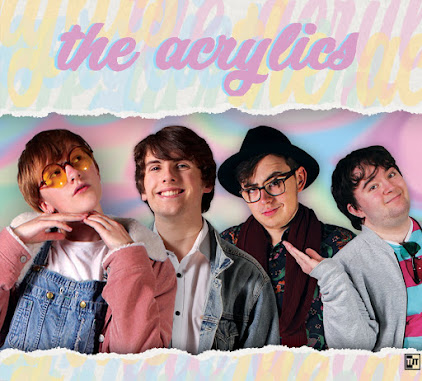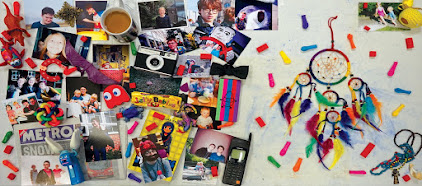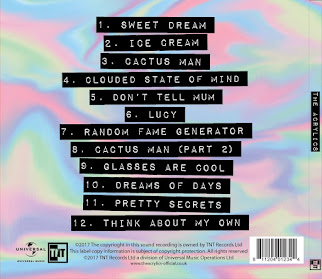This is my subgroup's version of our group's continuity video. Click to play.
1) Who did I work with and how did we manage the task between us?
To create this video, multiple people needed to work together effectively to get everything done within the set time frame.
Our group was comprised of (from left to right in the photo below) Tom Brown, myself and Jack Edmondson. However, for the editing portion of the task we split into two further groups who each created their own version of the clip- my subgroup included Jack and myself, while Tom worked alone.
Our group was comprised of (from left to right in the photo below) Tom Brown, myself and Jack Edmondson. However, for the editing portion of the task we split into two further groups who each created their own version of the clip- my subgroup included Jack and myself, while Tom worked alone.
 |
| Our group- Tom, myself and Jack. Please note: you can click any image in order to enlarge it. |
Our group dynamic was quite balanced throughout the process- by this I mean we all contributed fairly equally at each stage, especially planning, during which we all brainstormed ideas and formed a shared storyboard of all our best ideas put together. This was a beneficial arrangement as it ensured only the best shots and dialogue were added due to the open critique of each other's suggestions.
 |
| A shot of us collaborating on the storyboard- we are fine lining it for visibility late in the creation process. |
One possible exception was the shooting part of the activity, during which I did all of the camera work so the other two could focus on positioning and acting- however even during this segment we all directed each other and suggested tweaks and improvements to each other's work, which resulted in a higher standard for each area of filming (framing, acting, mise-en-scène and props etc.)
During editing, Tom of course simply worked by himself, but Jack and myself tried to split the work somewhat evenly, discussing possible opportunities for sound bridges and places where we could cut more from a shot to achieve the best effect. This meant neither of us was getting bored with constant editing or getting restless from not doing anything, but were still also always contributing.
During editing, Tom of course simply worked by himself, but Jack and myself tried to split the work somewhat evenly, discussing possible opportunities for sound bridges and places where we could cut more from a shot to achieve the best effect. This meant neither of us was getting bored with constant editing or getting restless from not doing anything, but were still also always contributing.
 |
| Me and Jack working together to work out some small problems with our sequence in the editing software. |
I think, overall, we worked very well as a group. Often being in a group can be a hindrance- mistakes affect multiple people, no single person has the control and thus can't fix everything themselves, and so on- but we worked so well together that actually it just meant we had more heads and hands working on all aspects of the project at once, meaning everything got done both faster and better.
2) How was the sequence planned? What processes were used? What theories were taken into account?
Planning was a very important part of this project- apart from being the foundation of all our ideas, we created things during the planning phase that we used throughout rest of the prelim.
The first thing we did was sit down and decide exactly what our story would be, including our two characters and some rough dialogue and other ideas on a piece of paper. This gave us a sense of direction for the next, more important document we produced, as well as for the rest of the activity.
via GIPHY
via GIPHY
via GIPHY
2) How was the sequence planned? What processes were used? What theories were taken into account?
Planning was a very important part of this project- apart from being the foundation of all our ideas, we created things during the planning phase that we used throughout rest of the prelim.
The first thing we did was sit down and decide exactly what our story would be, including our two characters and some rough dialogue and other ideas on a piece of paper. This gave us a sense of direction for the next, more important document we produced, as well as for the rest of the activity.
 |
| This is the original planning document. It was usurped by the storyboard but was essential to the process. |
Then, we created a storyboard. Our storyboard was slightly different from the standard, in that it was also a shootboard, script and props/costume list (accomplished by using spare space below the shots.) This was done in the interest of time, but it also served to provide us with a singular resource we could refer to for all our needs at any point in the project. However, it also meant that we lacked some specialisation and detail that we could have gained by producing multiple kinds of documents.
 |
| The storyboard/master document in full. It is quite a large document, so click to enlarge it if necessary. |
One important theory we took into account while planning was Narrative Theory- however, we didn't so much consider it as a theory per say, but upon reflection the planning process naturally followed the traditional pattern, most likely as a result of our education. The first shot establishes an equilibrium with one teacher, before another teacher quite literally causes a disruption. This leads to the conversation as an attempt to resolve the disruption, which results in the first teacher- after the second teacher has left- reaching his original equilibrium again, but somewhat changed due to the experience. Looking back, this order was very important to the process as a whole, as it gave us a base order to follow when the time came to actually create our shots.
Planning was a very useful stage in the project. Time restrictions meant we had to cut down in certain places, but the inherent usefulness of a storyboard meant by the end of this stage we were well and truly set up for the rest of the prelim.
3) What technology was used to complete the task, and how was it used?
We used a few different pieces of technology to create the end result of the video clip above, some higher tech than others but all useful, even essential, in their own way.
 |
| A table of all the equipment we used. Click to enlarge if the text is unclear. |
All the technology we used for the task was well-suited to what we needed to do, despite any small flaws they had and hiccups in the process they caused- in the end they enabled us to realise everything we dreamt up in the planning stage in a timely manner.
4) What factors were taken into account while planning, shooting and editing?
As this was a set project and not a free exercise, there were a number of restrictions and limitations on us during the whole activity. Two of these factors that had a particularly big effect were time and the classroom setting.
Possibly the main problem we had was the time restriction- we only had one planning session with a short extension is absolutely necessary, only one hour to film everything we needed with no leeway, and only a few sessions to get the editing perfect (not to mention the current time restrictions on this evaluation.) The time restriction did affect our final product, although only really at the planning stage- as we knew about the restriction from the beginning, we were able to plan for it and around it. Thus we kept our story and filming techniques simple so as to make it easier on us when it came to shoot everything and then cut it all together, and it seemed to work well for us.
The other factor, the classroom setting, meant we had to figure out how to keep the whole story inside the classroom as well as manage outside interference from the rest of the school. Luckily the room we used was quite removed from the rest of the school, so we didn't have to contend with other students and loud outside noises- whatever noise could have leaked in was blocked sufficiently by closing the windows. We also only filmed a few shots outside the classroom (and even then only the actor was outside the room, the camera was inside 100% of the time) to make sure we didn't encounter any other students in transit, or even the other group, as they were filming at the same time as us.
The classroom's layout itself also presented problems- it was a large room, so floor space fortunately wasn't a problem, but it had quite a lot of school furniture such as tables and chairs cluttering up the shooting space. We had to figure out the best way to create enough space for acting by keeping the unused furniture out of the shot, but at the same time ensuring the classroom setting looked realistic and believable. We did manage to achieve this, but we had to reorganize the room at the beginning and end of the shoot, which of course played into the aforementioned time restriction we also had to contend with. However, due to there being three of us, we managed to move everything around efficiently and quickly, and managed to reduce the impact of this problem on our video to basically nothing.
Despite our best efforts the final product is flawed in some ways, for example imperfect cutting and slight audio issues, but is close to what we originally envisioned.
5) How successful was the sequence? What worked well, and with hindsight what could be improved or done differently?
Following the brief was a key part of this project. It required us to create a continuity clip involving two characters- one starting sitting, and the other coming in and sitting down across from them to strike up a conversation. Of course all continuity rules, such as the 180 degree rule and shot-reverse-shot and so on, had to be followed.
In general, we were quite successful at following the brief- if you watch the video linked at the top of the post, you can see for yourself that one character is indeed sitting down at the very beginning of the clip, and another character does in fact come into the room, sit down across from them, and start a conversation. The actual story was quite easy to fit to the brief- the bigger challenge lie in the techniques used to create continuity themselves.
We used match-on action quite well; for example, when Jack's character (Mr. Spatula) walks past the door, despite the camera moving, his movement continues naturally on from the last shot. We also used another technique that wasn't directly in the brief but helped to maintain continuity in this segment- the 30 degree rule. Even though the camera jumps across the room with the same approximate framing between shots, the 30 degree rule is still obeyed as no characters are visible during the cut, meaning jumpiness/lack of smoothness is avoided.
We also obeyed the 180 degree rule and the shot order rule- in this short sequence, you can see that the camera changes perspective a few times yet always stays on one side of the characters, ensuring realistic and natural-feeling movement and position shot-to-shot, and also consistent eye direction between shots. The camera never moves from a long-shot to a close-up, but rather from a long-shot to a mid-shot to keep it looking smooth and without jump cuts. This same sequence, being right in the middle of a conversation, also obeys shot-reverse-shot by going between both character's views while they talk.
A major problem we did have though was that we had to cut three whole shots from the beginning of the clip. We realised late in the activity, with teacher guidance, that they were montage editing and thus didn't fit the brief. Luckily, we were able to use editing to work around the problem and the final video is mostly unchanged. Smaller problems include the lack of footsteps during the ellipsis of Mr. Spatula walking- we should have recorded the audio of footsteps and worked that in during editing- but as you can see from this silent .gif, this segment still works quite realistically without additional (or in this case any) audio.
In the end, we didn't have any huge unsolvable problems, and despite the problems we did have we managed to work to the brief for the most part.
6) What was learnt from completing this task? How will this information be significant in relation to future projects such as foundation coursework?
This project was a good start to the AS Course, as it allowed us to explore many different processes and techniques, which will be of use in our second video project. The next project is similar to this one in that it is a continuity sequence, however as it is the opening of a film it is more in-depth, with additional factors such as lighting, a proper script, music, sets/props and even opening/film-specific techniques like genre connotation and so on to consider.
For example, due to the focus on continuity, we should now all know how to maintain a good flow in any further video projects- even if they aren't based around continuity, they still need continuity in order to work as intended and avoid being jumpy. Apart from this focus, the fact that we got to practice storyboarding and editing is very beneficial. Storyboards are a key part of any visual project, as is editing- these are two directly transferable skills that should serve us well in any and all future tasks, such as when we are planning and editing the opening sequence.
Keeping this activity simple also allowed us to gain useful information; as we do not have to look through complications, we can see any fundamental flaws in our work- thus, we should be able to avoid repeating these mistakes in more important future work like the foundation coursework, ensuring a good base for the extra details and complications needed for a film opening.
Overall the experience of planning, filming and editing a video project was a great experience for us, as it will be something we have to do again in the future.




No comments:
Post a Comment